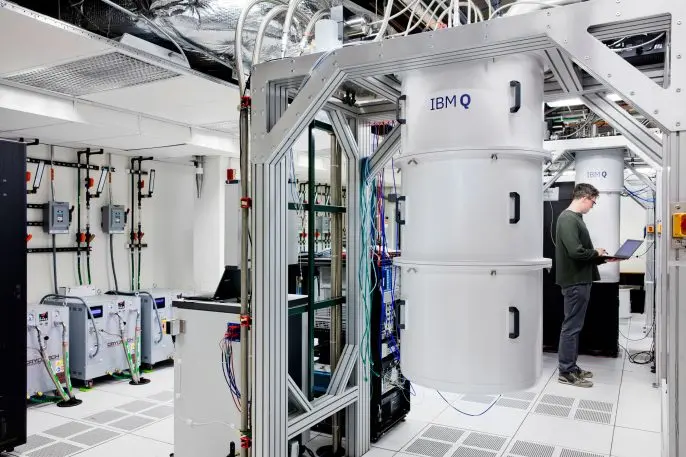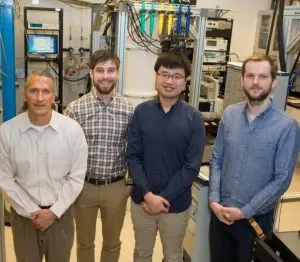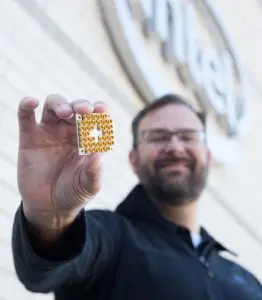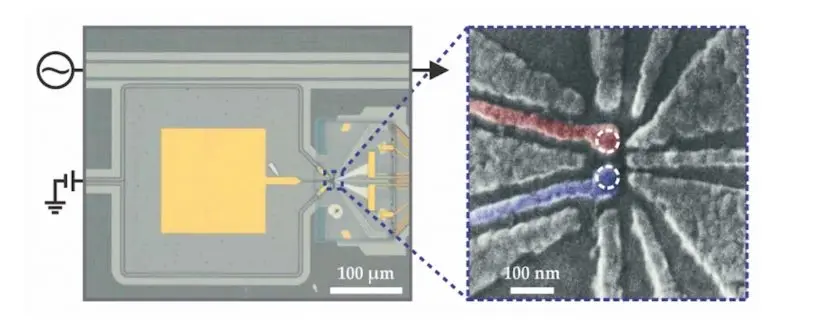The path forward in quantum computing is unclear, but for big governments and a range of companies, the destination isn’t: quantum advantage, or quantum supremacy, the point at which a quantum computer can outperform a classical computer at a particular task.
The global race is on. At latest count, the California company Rigetti is in the lead, as it aims to build a 128-qubit computer within a year.
Qubits, or quantum bits, are exponentially more powerful than the bits of classical computing. A bit is either “0” or “1.” But a qubit—based on the spin of an electron for instance—can be both states at the same time. One of quantum’s quirks is it effectively allows a system to compute problems with a vast multitude of different outcomes. The problems include everything from encryption-breaking and taxi routing to neuromorphic computing and molecule modeling. Some industries could experience “exponential speedups,” according to a recent commentary in Science.
But it’s early days. Even IBM, a pioneer of quantum information theory, already appears to be weary of the “hype.” Of course, it’s eager to commercialize the technology, too: Like Rigetti and D-Wave, it recently opened up its cloud-based resources to startups worldwide.

The company thinks it’s found a solution. It recently revealed its tiniest quantum chip yet–it’s so small that it can sit comfortably on a pencil eraser. The chip is powered by qubits that are each more than a thousand times smaller than a single strand of hair. In a typical superconducting quantum computer, qubits live in small loops of superconducting wire cooled to very low temperatures. Intel’s transistor-free chip relies on a more manageable, readily available, and quintessentially traditional component: silicon. Some researchers say the retro element that inspired an industry (and a metaphor, a competitive housing market, and a television show) might be key for the next phase of quantum computing.
“I am very optimistic about the status of silicon spin qubits,” says Jason Petta, a professor of physics at Princeton University. He recently authored a paper published in Nature that describes how his team successfully carried information about an electron’s spin—that is, its state—across a computing chip.
Petta’s team showed how to effectively schlep the data using light. By applying a microwave field, they were able to exchange a quantum of energy between an atom (an electron) and light (a microwave frequency photo). The result was a simple yet programmable system: the quantum control of a single electron, with the potential to send information to another qubit as much as a centimeter away.

For this work, silicon is key. It has the unique capacity to house special electron spin-orbit interactions that can be manipulated using only electricity. These interactions typically last longer in silicon than in other materials, but they can be difficult to control.
To combat the pesky problem of interference—including from the nuclei of the device itself—Petta and his colleagues used an array of double quantum dots. (Double dots work better than single dots because the electrons swap their spin states back and forth, which keeps the carefully choreographed exchange of information moving smoothly.
The new research demonstrates the potential for a silicon quantum chip that could scale up, Petta says. That could give other quantum computing researchers a run for their money.
“Single qubit gates”—the machine’s basic quantum circuits—”are at a level that is comparable to superconducting qubits, our most direct solid state competitor,” Petta says.

“That would be truly easier” than using superconducting qubits, Clarke says, “although it’s yet to be proven.”
He adds that silicon qubits have the potential to operate at “ever so slightly higher temperatures” than superconducting qubits. “What that means is you could probably put integrated circuits closer to the qubit plane. These will basically bring control electronics closer,” he says. Besides helping the devices scale even faster, silicon quibits could accelerate the miniaturization of machines that typically require their own rooms.
The device described in Petta’s paper runs on only two qubits, and Petta says scaling up will take a long time. His lab is now measuring a four qubit device.
“We have a working design for nine qubits that will keep us busy for a few years. Scaling beyond tens of qubits involves a significant amount of engineering,” he says.
Intel has partnered with another team conducting quantum-computing-through-silicon research: the Vandersypen lab at the Delft University of Technology in the Netherlands. It has committed $50 million over 10 years for the project. The company fabricates the chips near its headquarters in Oregon, and ships them to Delft to be characterized in quantum research.
The lab’s recent paper in Nature describes how silicon can be formed into a processor that crunches quantum algorithms. They created a programmable computer made from two quantum dots: a “two-qubit quantum processor in a silicon device.” One algorithm they executed, called Grover’s search, is known for its potential to dig up information in a database faster than traditional computers.

Toward life-changing numbers of qubits
The quantum computer of the future will be more than just a quantum processor, in the same way that today’s computer is more than just a microprocessor. The production depends on many moving parts, from the control electronics to the architecture.
Significant technical challenges remain unsolved. The questions are so complex that they don’t seem to stop: Can you get two qubits to talk to each other with a high enough (that is, requisite) fidelity? Can you get them to entangle? Once you have two qubits entangled, can you get the next pair entangled? And the next pair? And the next?
“Each qubit has its own personality today,” Clarke says. Even a device with 90% fidelity isn’t good enough to pass muster for a large-scale rollout. Yet research groups are inching closer. This year, a team reported fidelities over 60% using natural silicon, and another group recently pushed the two-qubit gate fidelity very close to 95% using isotopically enriched silicon.
“It is clear there is more work to do to achieve greater than 99% fidelity, but the increasing trend is encouraging,” Petta says. “We know which problems require our immediate attention to improve the two-qubit gate fidelity.”
Another fundamental limitation is the state of fast control electronics: They’re just not fast enough for spin qubits yet.
“These qubits don’t stick around very long,” Clarke says. Their coherence times are too short to work in a large-scale system. Though researchers have proposed algorithms that can put a qubit on life support—that is, extend its lifetime—they haven’t been proven yet.
Another key limitation, Petta emphasizes, is “material, material, material.” Spin qubits require exceptionally clean silicon, in terms of chemical purity and isotopic enrichment.
“To date, the U.S. hasn’t supported a significant materials-related program for spin qubits. I would like to see a significant effort on materials for spin-based quantum computing soon,” he says.
Washington has been showing more interest in quantum computing in general. The Department of Energy recently announced it is devoting $218 million for 85 quantum research projects across the country, and the National Science Foundation is earmarking $31 million in funding for quantum research. Petta’s own research into spin qubits has been funded in part by the Dept. of Defense, which is eager to beat Chinese government labs in the quantum race.
A bill moving through Congress could bring more welcome funds, and the National Quantum Initiative Act has already been approved by the House. If passed by the Senate, the act would provide $1.3 billion—with a “b”—over the next 10 years to support R&D in quantum computing.
Meanwhile, Rigetti is offering a $1 million prize to a team that can build an app on its 128-qubit system that demonstrates real-world quantum advantage. Generally, it’s thought that quantum computers need to compute using at least 50 qubits to begin outpacing the work of classical computers.
Still, estimating is a tricky problem. The number of qubits necessary to achieve quantum advantage for a particular computing task largely depends on the task, says Clarke. At Intel, he’s used protein-folding as an example goal to advocate for quantum computing internally, but believes that other applications will take much longer.
“I think that cryptography is sufficiently complex, so that the first- or second-generation quantum computer isn’t likely to have an impact,” he says. “It’s going to be a million qubits before a quantum computer is going to change your life or mine. And we’re a long ways away from that.”
Recognize your brand’s excellence by applying to this year’s Brands That Matter Awards before the early-rate deadline, May 3.